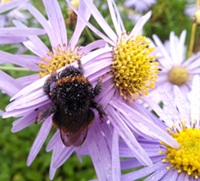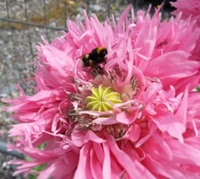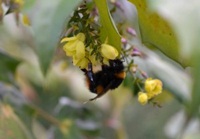![]()
We hear so much about the desperate plight of the bees but is the message getting through?

Scientists are still working to determine what exactly is causing their global demise, but as a result of the Varroa mite, *there are no wild honeybees left in Ireland.

As we begin to sow seeds, tidy our gardens and think about shrubs and summer blooms, it’s important to remember bees need our help if they are to survive.
I came across this alarming yet hopeful TED talk by Marla Spivak recently where she eloquently speaks about the plight of the disappearing bees which is worth listening to. At the end she highlights a couple of things that each and every one of us can do to help the bees and why it’s important that we do them now. I’ve added a few more…
Watch video HERE.
Five things we can do right now to help the bees that will make a difference
1. Don’t contaminate the flowers that are growing. Stop spraying pesticides and herbicides on flowers that the bees feed on and ingest – that includes the “weeds” such as dandelion that are a veritable spring feast for bees as they emerge. Always err on the side of caution – if you’re still using chemicals and are not sure if they’re harmful to bees or not, DON’T USE THEM. The RHS carry a lot of information about bees on their website, including a list of withdrawn chemicals that can be referred to.

2. Plant more bee friendly flowers.
If you’ve a large area to plant, Sandro’s Irish Wildflower Conservation Grade Seed Mix might be for you. Not only will the birds, bees and butterflies love you for it, wildflowers are low maintenance (they generally only need one cut per year) and look stunning when in flower too.

Once again, the RHS have a very detailed list of plants for pollinators on their website here, which will give you ideas for bee attracting climbers, trees, bulbs and corms, as well as annual, biennial or perennial flowers.
You could also plant herbs or vegetables that bees will enjoy feeding upon such as asparagus, broad beans, courgettes and other members of the squash family, hyssop, marjoram, mint, rosemary, runner beans, sage, thyme and allow some of them to flower too such as brassicas.
3. Take direct action.

Greenpeace are running a campaign asking people to support ecological farming, ban bee harming pesticides and adopt action plans that will help to monitor the situation. If you’d like to sign the petition and/or donate to the cause, click the link here.
4. Create Bee-Friendly Zones
Bees like nooks and crannies to nest, feed and hang out in. Learn how to garden without chemicals, plant bee friendly plants, make bee nest boxes or hotels and encourage your friends, neighbours, schools, creches, and clubs to do the same in Bee-Friendly Zones.
Encourage councils and tidy town groups to plant bee friendly flowers among hedgerows and verges and remind farmers to leave strips of wild flower areas on the edges of their fields and resist spraying them with herbicides and pesticides, which will provide the bees with unpolluted food help to ensure their survival.
If you’re looking for ideas on habitats, here’s a Pinterest board full of bird, bee and pollinator friendly homes and feeders.
5. Start a Campaign

Although there’s a breeding programme to protect the native Irish honeybee, as far as I can make out there’s no national campaign in Ireland to raise awareness about the plight of the bees and how important it is that we protect and help them, so consider starting one!
Encourage your communities to plant more bee friendly flowers, stop spraying unnecessarily and plant more wildflower verges and roundabouts instead of spraying and mowing.
Let’s get bees into the news and help to raise an awareness that will stop people spraying and more people planting. What do you think? Are you up for the challenge?

Dee Sewell – a horticulturalist and certified trainer who started Greenside Up in 2009 and teaches people how to grow vegetables. Dee specialises in working with community gardens but also offers workshops, allotment visits, consultations, horticultural therapy, afterschools clubs as well as local talks – she tailors her services to meet clients needs. In 2012 Dee launched a Seed Gift Collection containing varieties of vegetable and insect friendly flowers with the aim of getting more people growing. Dee’s blog was a finalist in the 2012 Ireland Blog Awards in the Eco/Green and Lifestyle Categories.
Source: GreensideUp – Five Ways to Help Bees Now – Dee Sewell




